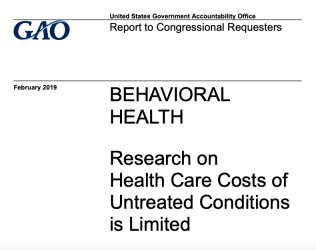Behavioral Health
Research on Health Care Costs of Untreated Conditions is Limited
February 2019
Sponsor:

Why GAO Did This Study
Behavioral health conditions affect tens of millions of Americans. When these conditions go untreated, they can lead to other health care costs, some of which may be borne by publicly-funded health care programs. For example, those with untreated behavioral health conditions may also require treatment for other medical conditions, such as diabetes or heart disease, which may be exacerbated by the untreated behavioral health condition. GAO was asked to describe what is known about adults with untreated behavioral health conditions. This report examines (1) reasons why some adults with behavioral health conditions do not receive treatment for their condition, and (2) what is known about the health care costs associated with untreated behavioral health conditions in adults. GAO reviewed SAMHSA’s most recent survey data from its annual National Survey on Drug Use and Health. GAO also conducted literature searches and reviewed articles on 1) reasons why adults do not receive treatment for their behavioral health conditions and 2) the health care costs associated with untreated behavioral health conditions. In addition, GAO moderated a meeting with behavioral health experts— selected with assistance from the National Academies of Sciences, Engineering, and Medicine—to discuss behavioral health conditions and health care costs associated with them. GAO also interviewed federal officials and other relevant stakeholders. The Department of Health and Human Services and the Department of Defense provided technical comments on a draft of this report, which we incorporated as appropriate.
What GAO Found
According to 2017 survey data from the Substance Abuse and Mental Health Services Administration (SAMHSA), an estimated 56.8 million adults had a behavioral health condition—that is, a substance use or mental health condition. An estimated 39.7 million of these individuals did not receive treatment for their behavioral health condition in the past year, with more than 80 percent not perceiving a need for treatment. The survey also indicates the reasons why individuals who perceived a need for treatment did not receive it, including cost, stigma, and access challenges, such as not knowing where to go for treatment.
Not treating behavioral health conditions can lead to other health care costs, such as the costs of emergency care for an overdose. However, GAO found that research on such costs is limited and there is no generally accepted estimate of all the health care costs associated with untreated behavioral health conditions. According to experts GAO met with, available research in this area is limited by methodological challenges, including determining which health care costs can be attributed to an untreated behavioral condition, and by limited data on the full prevalence of certain behavioral health conditions. The 29 studies GAO reviewed compared the health care costs associated with treating and not treating certain behavioral health conditions in adults. These studies were limited in scope—
focusing, for example, on specific behavioral health conditions and specific geographic areas. Among these 29 studies,
- 20 found higher health care costs associated with untreated adults,
- 6 found that health care costs were lower for untreated adults, and
- 3 reported either mixed results or no observable difference.
Experts and stakeholders cited reasons why untreated behavioral health conditions can be associated with higher health care costs. For example, adults with untreated behavioral conditions may have other related, physical health conditions that may not be well managed and have their own costs.
| Attachment | Size |
|---|---|
| 1.36 MB |
Full Resource/Source: Behavioral Health: Research on Health Care Costs of Untreated Conditions is Limited
Secondary menu
Copyright © 2024 Primary Care Collaborative



